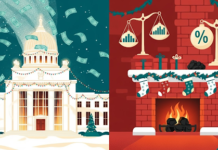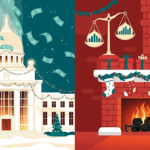Market optimism vs. hidden risks—get the full story.
Markets started the week on a positive note, but don’t get too comfortable—big questions remain. Investors have been closely watching economic signals, and JPMorgan warns that tariff uncertainty and economic turbulence may not have peaked yet. With Friday’s jobs data looming, traders are bracing for what could be a volatile week.
The warning from JPMorgan strategists points to shaky economic data—consumer confidence, retail sales, and services activity have all shown signs of weakening. Add to that a nervous Federal Reserve, and you have the recipe for a potentially tricky second quarter.
So what’s the best investment move right now? JPMorgan’s take: defensive stocks could be the safer bet while the market figures out its next step. Meanwhile, the long-running dominance of big tech may be giving way to a new rotation trend.
This Week I Learned…
Tariffs & Markets: A Love-Hate Relationship
Trade wars and tariffs are nothing new, but how much do they actually impact the markets? Historically, tariffs have been less about direct economic damage and more about uncertainty—something markets hate.
Take the Smoot-Hawley Tariff Act of 1930, for example. Many blame it for deepening the Great Depression, but in reality, the stock market had already collapsed months earlier. While tariffs did hurt trade, the panic they created in global markets did just as much damage.
Fast forward to the U.S.-China trade war in 2018-2019, and we saw a similar pattern. Markets swung wildly—not just because of the tariffs themselves, but because of uncertainty over what would happen next. The S&P 500 saw a correction, but once policy direction became clearer, markets recovered.
So, what’s the takeaway? Tariffs can absolutely be disruptive, but they often don’t singlehandedly crash the market. The real risk is uncertainty—and that’s exactly what we’re seeing today.
The Fun Corner
Market Valuations: Stretched or Just Doing Yoga?
Investor 1: “I heard the market’s at a 22x forward P/E ratio. That’s way too high!”
Investor 2: “Nah, it’s just practicing deep stretching before the next rally.”
But seriously—JPMorgan’s strategists say the U.S. market’s valuation is looking “very stretched” at 22 times forward earnings. That’s historically high, and while high valuations don’t guarantee a crash, they do suggest less room for upside unless earnings keep up.
For now, let’s just hope the market doesn’t pull a muscle.
Inflation Worries Re-Emerge as Market Stability Faces Fresh Tests
JPMorgan strategists are sending a clear message: investors may be underestimating the risks ahead. While markets have been relatively stable, signs of economic turbulence are growing—and it’s not just about tariffs.
Key Warning Signs
1️⃣ Economic data is slipping – Consumer confidence, retail sales, and services activity have all started to wobble.
2️⃣ Market concentration remains high – The biggest stocks are carrying the market, but JPMorgan warns that valuations are stretched.
3️⃣ Tech rotation continues – A shift from semiconductors to software is underway, signaling broader sector changes.
4️⃣ The Fed is in a tough spot – Inflation is keeping rate cuts on hold, but a slowing economy could change that later in the year.
What This Means for Investors
JPMorgan believes that tariff uncertainty has not peaked—even if no new tariffs are introduced, the psychological impact on investors and businesses could still create headwinds. This echoes patterns seen in past trade disputes, where the fear of uncertainty itself drove market volatility.
For now, defensive stocks may offer a safer play as investors wait for clarity. JPMorgan remains neutral on U.S. stocks overall, citing high valuations and a heavily concentrated market. However, they do believe the U.S. economy remains stronger than other global markets, which could help American equities hold up better during risk-off periods.
The Last Say
A Market in Limbo
JPMorgan’s latest analysis raises a critical question: Are markets being too complacent? While investors have largely shrugged off recent economic jitters, underlying risks are starting to stack up.
Tariff uncertainty, shaky economic data, and high market valuations suggest that caution may be warranted. Friday’s jobs report will be a key moment—a strong report could ease fears, while a weak one could reignite volatility.
For investors, this is a time to focus on portfolio balance. Defensive stocks may provide stability while market direction remains unclear. And for those eyeing opportunities? Watch for sector rotations—tech may no longer be the safest bet.
Markets are holding steady for now, but the question remains: For how long?























